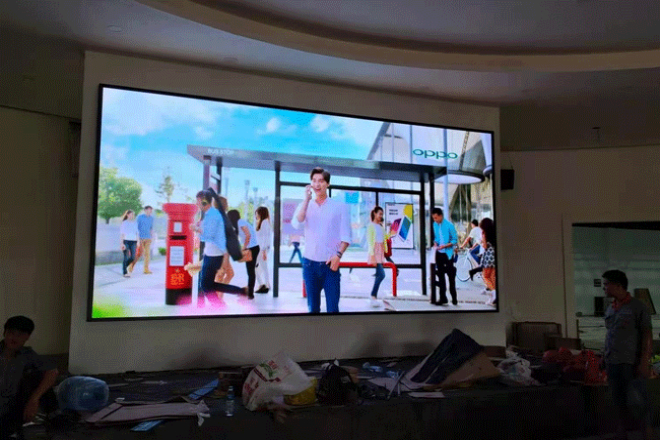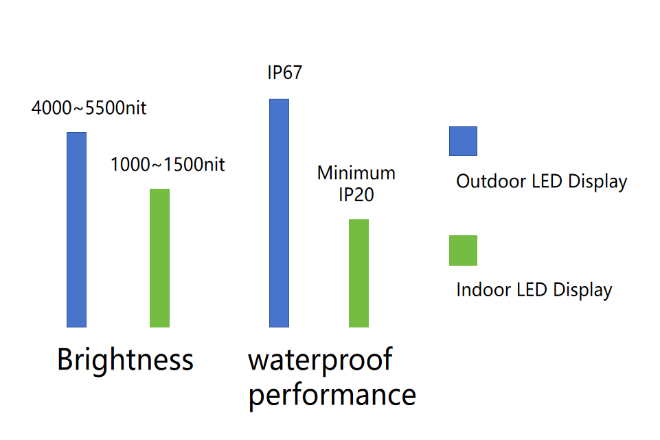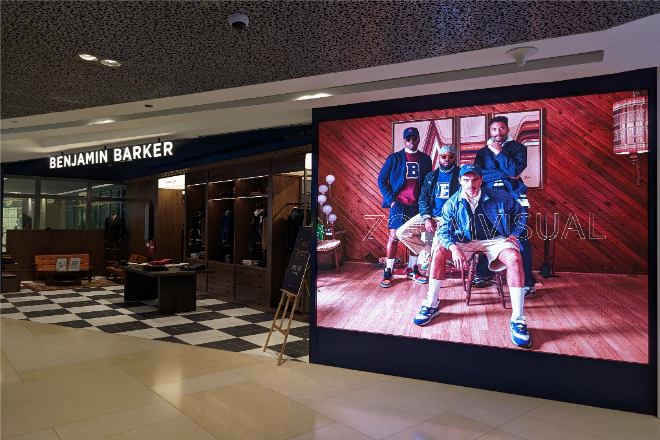Introduction

Whether indoor LED screens can be used in outdoor environments has always been controversial.
Some people believe that as long as protective measures are taken, indoor LED screens can also be used outdoors, while others insist that there are fundamental differences in design and performance between indoor and outdoor LED screens, and they cannot be confused. So, can indoor LED screens really be used outdoors?
1. Analysis of the differences between indoor and outdoor LED screens

1). Brightness
1.1). Indoor LED screens:
The brightness design is relatively mild. Think about it: the indoor ambient light is relatively dark, and if the screen is too bright, the eyes can’t stand it. Therefore, the brightness of the indoor LED screen is just right, which makes people feel comfortable.
It uses a dynamic scanning circuit. This circuit is quite smart, which can reduce costs and make the screen display quite clear. It is completely fine to use it indoors.
1.2). Outdoor LED screens:
The brightness is awesome! The outdoor light is so strong; who can see it clearly if the screen is not bright? Therefore, the brightness of outdoor LED screens is adjusted very high to ensure that everyone can see clearly in any light.
It uses a static scanning circuit. This circuit is more stable and less prone to problems. The outdoor environment is so complicated that it is much more reassuring to use a static scanning circuit. Moreover, the display effect is better, and the picture is clearer.
2). Waterproof
2.1). Indoor LED display:
The indoor environment is relatively dry, so the waterproof requirements are not so high. Some screens may not be waterproof at all, or they are simply waterproof.
But then again, if the indoor environment is relatively humid, or there is a possibility that water will splash onto the screen, then some waterproof measures must be taken. After all, no one wants the screen to be damaged due to water ingress, right?
2.2). Outdoor LED display:
The waterproof requirements are very high! The outdoor environment is so changeable that it may rain at any time. Therefore, outdoor LED screens pay special attention to waterproofing during production.
The key components, such as cables and boxes, are made tightly to ensure that water cannot enter. In this way, even if it rains heavily, the screen can work normally without worrying about water ingress.
3). Viewing distance and model
3.1). Indoor LED display:
The viewing distance is relatively close, so the screen resolution requirement is high. Everyone is so close to the screen that if the picture is not clear, it will be embarrassing.
The models are generally P3, P4, P5, P6, etc. These models actually mean the pixel pitch. The smaller the pitch, the higher the resolution and the clearer the picture.
The area is generally not large. Indoor space is limited, and a large screen will block the line of sight and make people uncomfortable.
3.2). Outdoor LED display:
The viewing distance is much longer. Everyone may stand far away to watch the screen, so the brightness must be high, and the picture must be large enough.
The models are generally P10, P16, P20, etc. Although the pixel pitch is larger than that of indoors, the outdoor viewing distance is far, so the picture looks quite clear.
The area is huge! The outdoor space is open, so the screen must be larger to attract everyone’s attention. Moreover, the large screen looks more shocking and more exciting!
2. What are the challenges of using indoor LED screens outdoors?
1). Insufficient brightness
You know, the brightness of indoor LED screens is quite comfortable to look at indoors. But once you go outdoors, especially on sunny days, the screen is covered with a layer of gauze and you can’t see anything clearly.
This is because the indoor screen was not designed with the strong light outdoors in mind, so the brightness is not enough, and it is difficult to use it outdoors.
1.1). Actual impact:
Imagine that you are holding an outdoor event and want to put an advertisement or notification, but the screen is as dark as if it is not turned on, and everyone can’t see it clearly even if they get close.
This not only wastes money but also makes people think that your event is unprofessional and affects your image.
2). Insufficient waterproof performance
Some indoor LED screens may be a little waterproof, but they are only splashproof. Outdoors are different: rain, snow, dew, and all kinds of weather.
If the screen is not waterproof, once water enters, the circuit will short-circuit, the components will be damaged, and the screen will be scrapped.
2.1). Actual impact:
If the outdoor screen is not waterproof, it is simply a time bomb. Maybe one day it will rain and the screen will break, and you will have to spend money to repair it.
Moreover, broken screens are uncomfortable to look at, affect appearance, and may also pose safety hazards to people.
3). Poor viewing effect
The models and sizes of indoor LED display screens are designed according to the distance and angle of indoor viewing. It is different outdoors. People stand far away, and the viewing angle is also large.
Therefore, when the indoor screen is used outdoors, the picture will be blurred, the details will not be clear, and the viewing effect will be greatly reduced.
3.1). Actual impact:
If the outdoor screen has a bad viewing effect, then everyone might as well not watch it. If you put an advertisement, but no one can see what it is, then the advertisement is not put in vain.
Moreover, poor viewing effect will affect the atmosphere and effect of the event, making everyone feel that your event is meaningless.
4). Extra challenges
In addition to the three major problems mentioned above, there are other small troubles when using indoor LED displays outdoors:
4.1). Large temperature changes:
Outdoor temperature is sometimes high, and sometimes low, and indoor screens may not be able to withstand such changes. When the temperature is high, the screen may overheat; when the temperature is low, the screen may be frozen and slow to respond.
This will affect the service life and the screen display effect.
4.2). Dust and pollutants:
There is a lot of dust and pollutants outdoors. This dirt is easy to stick to the screen, making the screen look dirty.
Moreover, dust and pollutants may also affect the heat dissipation performance of the screen, making the screen more prone to damage.
4.3). Difficult installation and maintenance:
The outdoor environment is complex, and many factors must be considered when installing the screen. For example, the screen must be installed firmly to prevent it from being blown away by the wind; it must also be anti-theft to prevent it from being stolen.
Maintenance is also troublesome, and regular inspections, cleaning, and repairs are required. These will increase costs and time.
So, it is really challenging to use indoor LED displays outdoors. To be on the safe side, it is better to choose a special outdoor LED display. In this way, whether it is brightness, waterproofing, or viewing effect, it can meet outdoor needs.
3. Suggestions and solutions if you want to use LED display screens outdoors

1). Choose a dedicated outdoor LED display screen
When planning to use LED display screens in outdoor environments, the first consideration is to choose a dedicated LED display screen suitable for outdoor use.
This is because the outdoor environment has higher requirements for the brightness, waterproof, dustproof, UV resistance, and other performance of the display screen, and the dedicated outdoor LED display screen is designed for these needs.
1.1). Specific suggestions:
- Choose models according to the usage scenario:
Different outdoor environments have different performance requirements for the display screen.
For example, in open areas with direct sunlight, you need to choose a display screen with higher brightness; at the seaside or in a humid environment, you need to choose a display screen with better waterproof and corrosion resistance.
- Consider viewing distance and viewing angle:
The outdoor environment has a long viewing distance and a wide viewing angle, so you should choose a display screen with higher resolution and wider viewing angle to ensure the viewing effect.
- Avoid unnecessary risks and costs:
Choosing a dedicated outdoor LED display screen can avoid failures and maintenance costs caused by insufficient performance while also ensuring display effect and service life.
2). Technical upgrade and transformation
2.1). Possibilities and limitations:
Under certain circumstances, if the indoor LED display screen is technically upgraded or transformed, it may be adapted to the outdoor environment to a certain extent.
However, this transformation is often limited by the hardware and circuit design of the original display screen, the cost is high, and the effect may not be as good as that of a dedicated outdoor screen.
2.2). Specific suggestions:
- Evaluate the feasibility of transformation:
Before deciding to transform the indoor LED display screen, you should fully evaluate whether its hardware and circuit design support the use requirements of the outdoor environment.
If the transformation is difficult or the cost is too high, it is recommended to directly replace it with a dedicated outdoor screen.
- Choose a professional transformation team:
If you decide to transform, you should choose a team with rich experience and professional technology to operate to ensure the effect and safety of the transformation.
- Consider the performance improvement after the transformation:
After the transformation, you should pay attention to the performance improvement of the display screen in terms of brightness, waterproofness, dustproofness, etc., and ensure that it meets the use requirements of the outdoor environment.
3). Professional installation and maintenance
Professional installation and maintenance are the keys to extending the service life of the LED display screen and ensuring the display effect.
The outdoor environment is complex and changeable, which puts higher requirements on the installation and maintenance of the display screen.
3.1). Specific suggestions:
3.1.1). Professional installation:
- Choose a professional team:
A team with rich experience and professional skills should be selected to install the display screen.
- Consider environmental factors:
During the installation process, the particularities of the outdoor environment, such as light conditions, climate conditions, installation location, etc., should be fully considered.
- Ensure a stable installation:
The display screen should be installed firmly and reliably to prevent shaking or tipping caused by natural factors such as wind and rain.
3.1.2). Professional maintenance:
- Regular cleaning:
The surface and interior of the display screen should be cleaned regularly to prevent dust and pollutants from affecting the display screen.
- Check the connectors:
Check the connectors of the display screen regularly for looseness or corrosion, and tighten or replace them in time.
- Waterproof and moisture-proof:
Pay special attention to the waterproof and moisture-proof performance of the display screen to ensure that it can work normally in a humid environment.
- Professional maintenance:
If the display screen fails, contact a professional maintenance team for maintenance in time to avoid self-disassembly or repair that may cause greater losses.
Conclusion
In summary, there are significant differences between indoor LED display screens and outdoor LED display screens in terms of brightness, waterproof performance, viewing distance, and model.
Although indoor LED displays may be adapted to outdoor environments to a certain extent through technical upgrades or modifications in certain circumstances, their limitations and risks cannot be ignored.
Therefore, we strongly recommend that when choosing an LED display, you should choose a dedicated indoor or outdoor model based on the actual usage scenario and needs to ensure the best display effect and service life.
Finally, if you want to know more about LED displays, please get in touch with us.
